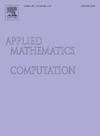海洋-大气相互作用的平流-扩散耦合模式的稳定性、能量守恒和收敛性分析
IF 3.4
2区 数学
Q1 MATHEMATICS, APPLIED
引用次数: 0
摘要
这项工作的主要重点是研究海洋-大气耦合,使用具有两个耦合条件的耦合平流-扩散方程建模:Dirichlet-Neumann (DN)和热通量条件,定义在两个不重叠的域上。数值逼近采用有限体积法(FVM)和有限差分法(FDM)。采用广义最小残差(GMRES)方法对耦合问题进行收敛性分析。我们得出结论,中心差分格式保证了热流耦合下的守恒,而单侧差分引入误差导致能量不守恒。而对于dn -耦合,则保持单向守恒。基于Fourier分析和Godunov-Ryabenkii (GR)稳定性理论的正态技术的稳定性分析揭示了显式方案比隐式方案更严格的稳定性约束。采用GMRES方法实现数值收敛。结果表明psamclet数(Pe)的变化如何影响溶液的行为,从扩散驱动的平滑过渡到平流驱动的锐度,同时保持跨域的物理一致性。所提出的算法经过严格的数值验证,结果通过详细的图表和数值表说明,证明理论预测和计算结果之间的强烈一致性。本文章由计算机程序翻译,如有差异,请以英文原文为准。
Analysis of stability, energy conservation, and convergence of coupled advection-diffusion models for ocean-atmosphere interactions
The main focus of this work is to study ocean-atmosphere coupling, modeled using coupled advection-diffusion equations with two coupling conditions: the Dirichlet-Neumann (DN) and the heat flux condition, defined across two non-overlapping domains. For numerical approximation, the finite-volume method (FVM) and finite-difference method (FDM) are applied. The convergence analysis of the coupled problem is conducted using the Generalized Minimal Residual (GMRES) method. We conclude that central difference schemes ensure conservation under heat flux coupling, while one-sided differences introduce errors leading to energy non-conservation. While for the DN-coupling one sided maintain the conservation. The stability analysis, based on Fourier analysis and normal mode techniques from Godunov-Ryabenkii (GR) stability theory, reveals stricter stability constraints for explicit schemes compared to implicit ones. The GMRES method is used to achieve numerical convergence. The results demonstrate how variations in the Péclet number (Pe) influence the behavior of the solution, transitioning from diffusion-driven smoothness to advection-driven sharpness, while maintaining physical consistency across the domains. The proposed algorithms undergo rigorous numerical validation, with results illustrated through detailed graphs and numerical tables that demonstrate strong agreement between theoretical predictions and computational outcomes.
求助全文
通过发布文献求助,成功后即可免费获取论文全文。
去求助
来源期刊
CiteScore
7.90
自引率
10.00%
发文量
755
审稿时长
36 days
期刊介绍:
Applied Mathematics and Computation addresses work at the interface between applied mathematics, numerical computation, and applications of systems – oriented ideas to the physical, biological, social, and behavioral sciences, and emphasizes papers of a computational nature focusing on new algorithms, their analysis and numerical results.
In addition to presenting research papers, Applied Mathematics and Computation publishes review articles and single–topics issues.

 求助内容:
求助内容: 应助结果提醒方式:
应助结果提醒方式:


